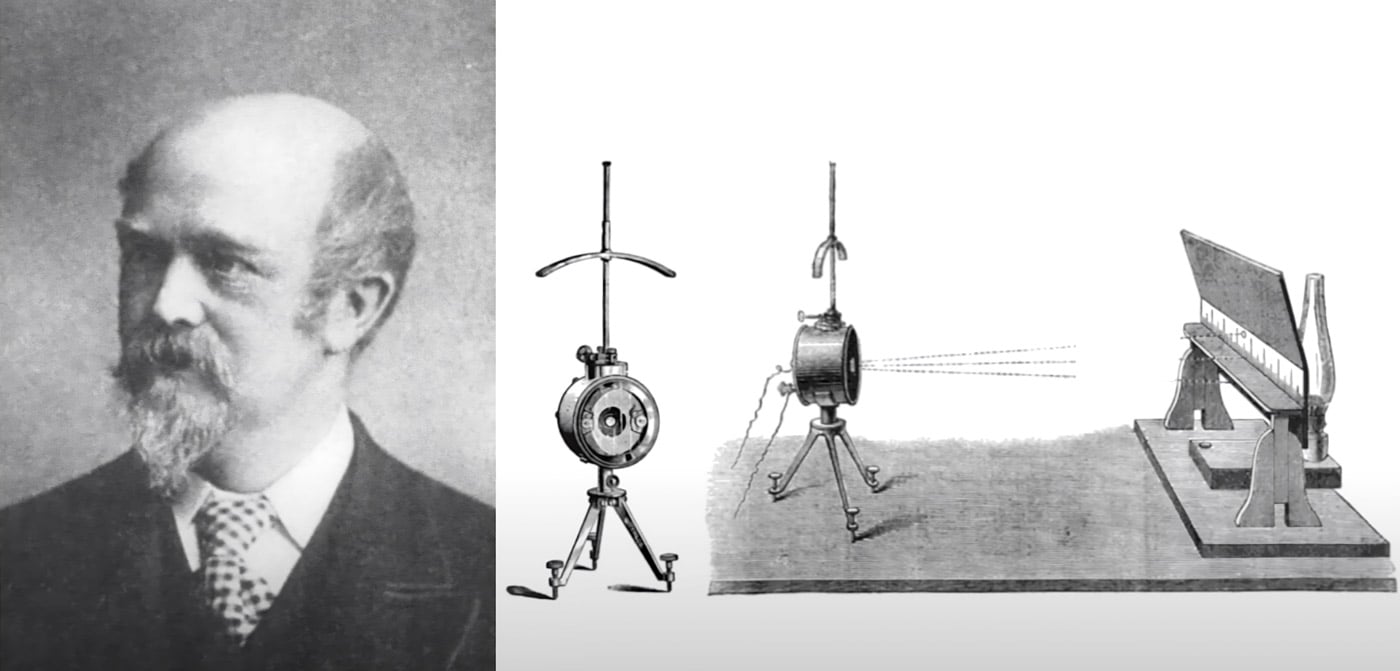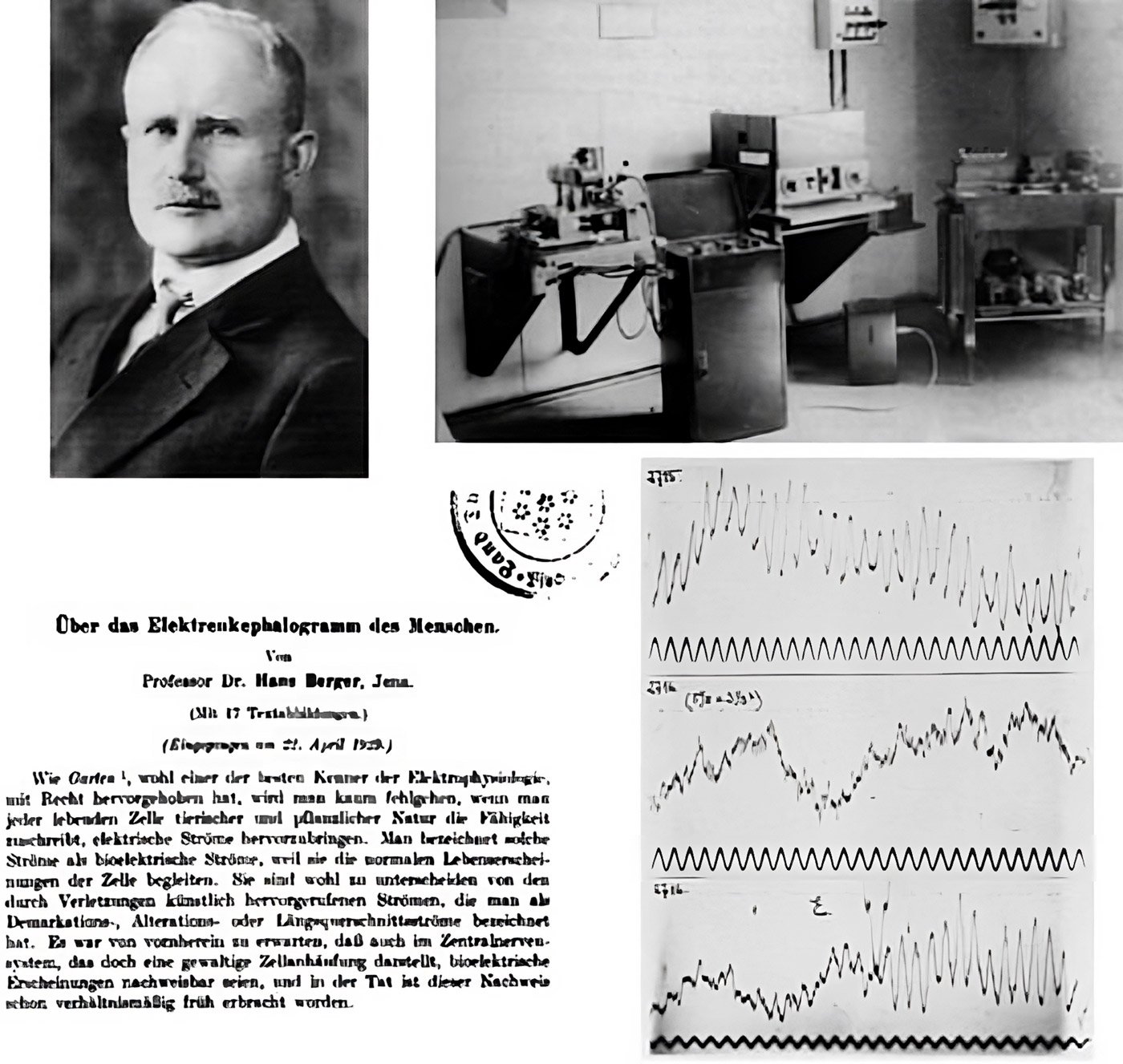
the birth of Neurofeedback was taken on by other major discoveries upstream, and that goes back a long way!
In ancient times, it was discovered that certain electric fish could cure migraines: a first link was made between electricity and the human body (brain).
100 years BC: discovery of the bio-electric phenomenon with amber called “electron” by the Greeks (static electricity phenomenon).
In 1875 Dr. Richard Caton noted that mental activity is followed by fluctuations in the electrical activity of the brain in animals.

Image source: Richard Caton EEG pioneer (YouTube video) →
But it was not until 1920 that it was possible to measure and record this activity on paper thanks to Dr. Hans Berger: the human electroencephalogram (EEG) as we know it was born. Berger was the first to identify the types of brain waves: delta, theta, alpha, beta and gamma.

Image source: Hans Berger and the first EEG →
Then in the late 1960s, Joseph Kamiya discovered that it was possible to train different brain waves: his team taught volunteers to recognize alpha waves (9-12 Hz) on the EEG by giving them positive verbal reinforcement every time alpha waves appeared. The experiment was a success, demonstrating what is called the learning loop, the basis of Neurofeedback today: alpha brain activity could be reinforced in the participants with positive verbal encouragement. Humans, like animals, are able to control their own brain activity.
After this discovery, in 1968, Dr. Barry Sterman performed an experiment proving that the sensorimotor rhythm (12-15 Hz) reduces epileptic seizures in cats. He is the “father” of Neurofeedback!
His team wanted to replicate Pavlov’s study and the dog to train the cats’ brains. In a first experiment, about 30 cats learned that by pressing a lever in their cage, they received food.
Then Stermann added a sound signal: if the cats pressed the lever during the sound, they did not receive food. They had to wait for the sound to end before they could press the lever and get food. The researchers found that the mental state of the cats changed while they were waiting for the sound to end: the animals were still but their brains were alert, waiting for the signal to end. In the electroencephalogram (EEG), this is called the sensorimotor rhythm, or SMR waves.
These animals then participated in a second study: no more levers, the cats had to produce the SMR frequency on their own to receive food. Surprise for Sterman! Very quickly, the felids were able to reproduce these desired frequencies at will. So the brain and its functioning could be conditioned through EEG observation.
He also observed outside the conditioning experiment that the increase in SMR waves improved the quality of sleep: the cats were not stressed or nervous. Why? Because the increase of SMR waves increased the beta spindle during sleep: this allows to have a deep and quality sleep.
As his results were not taken seriously at the time, he did a “reversible” experiment called deconditioning: he reduced the SMR waves and at the same time the beta spindle waves via the same principle as before in these cats. Result : the cats were much more physically agitated. From then on, this was not the result of chance, nor of a placebo but of conditioning.
At the same time, NASA had contacted Sterman’s researchers because it was interested in the effects of hydrazine (rocket fuel) which caused epileptic seizures in astronauts.
For their study, this fuel was tested on 50 cats, which, not surprisingly, triggered severe epileptic seizures with negative symptoms. But some of the cats had a much higher tolerance threshold and triggered seizures much less quickly: Sterman realized that these were the cats that had participated in the EEG conditioning experiment and thus increased their SMR waves.
This result was proof that induced brain changes had a real impact at the physiological level and were of therapeutic interest.
The researchers applied this knowledge to Mary Fairbanks, a woman who suffered from epilepsy: her left hemisphere in the sensorimotor cortex was trained using EEG equipment. A green light appeared when the SMR rhythm increased and a red light appeared when the SMR rhythm decreased. After 3 months of Neurofeedback training, Mary’s seizures had decreased significantly.
This major discovery opened the field for Neurofeedback and a treatment for epilepsy from the very beginning. Thus researchers will use neurofeedback to reduce the frequency of epileptic seizures by a factor of 10.
In 2009, a team identified a dozen studies treating a total of 87 patients with drug-resistant epilepsy. After Neurofeedback treatment, the frequency of seizures was significantly reduced in 74% of them. Other researchers even report seizure suppression when Neurofeedback training protocols are specifically adapted to the brain dysregulations of each patient after 35 sessions.
These initial findings on the therapeutic potential of Neurofeedback will open up a whole new field of research on many pathologies associated with brain dysregulation, such as:
During the 70s and 80s, the first normative databases appeared. These databases allowed the comparison of brain waves of each individual to a normative sample of the population in order to establish a link between these signals and a variety of symptoms (fatigue, difficulty to concentrate, anxiety…). Pioneers in this field are Frank Duffy, Roy John and Robert Thatcher among others. These Quantitative EEG data allow us to obtain a general topographic image of the cortex in activation, called the Brainmap.
In 1989, Eugene Peniston and Paul Kulkosky defined a specific Neurofeedback protocol for Vietnam veterans (in connection with the work of Dr. Bessel van der Kolk) to treat post-traumatic stress disorder. Their studies were successful, adding Neurofeedback to the therapeutic possibilities for psychological trauma.
At the same time, thanks to the rapid advent of technology and computers, the first computerized Neurofeedback equipment appeared.
Functional MRI Neurofeedback started in 1995, it offers a very good spatial resolution of the brain but is very expensive. It is mainly used in research.
Starting in 2010, controlled studies on Neurofeedback began to be more numerous with scientifically valid protocols. Notably, that of Young and colleagues (2017) who conducted a randomized, double-blind, placebo-controlled study of the amygdala in people with depression. This study shows a reduction in the severity of depression in the group performing Neurofeedback actively from the second training session.
Recently, a study of Neurofeedback in fMRI showed favorable results for the treatment of Tourette’s syndrome and schizophrenia. The door to mental health is open and growing, combined with other therapeutic techniques, the results are very encouraging for Neurofeedback.
This technique has also been extended to non-medical fields such as sports or work to increase sports and mental performance.
Today there are many applications of therapeutic Neurofeedback and its implementation methods are very diverse. The incredible increase in knowledge about the brain only makes Neurofeedback training more precise and optimized, making this technique ever more effective. For example, the Loreta Z-Score Neurofeedback, developed by Robert Thatcher, not only trains the brain on its surface but also reaches deeper structures with the help of highly advanced mathematical algorithms.
Science has not yet finished discovering all the potential that Neurofeedback can bring to performance and mental well-being (photobiomodulation, ERP,…), to be continued…!
We are not doctors or psychiatrists. Therefore, we do not diagnose, we do not prescribe medication, we do not cure illnesses and we are not an emergency center. We often help people reduce or even stop their medication in agreement with the health professional who follows you. Please note that you do not need a prescription or a diagnosis to make an appointment at Neurofeedback Luxembourg.
We promise we will only send you quality content. You can unsubscribe at any time.
We promise we will only send you quality content. You can unsubscribe at any time.